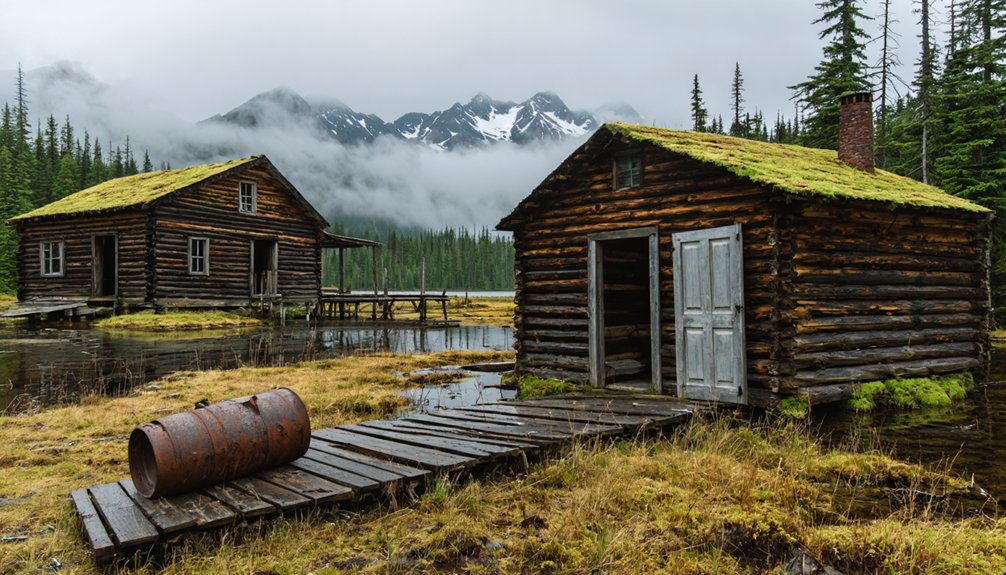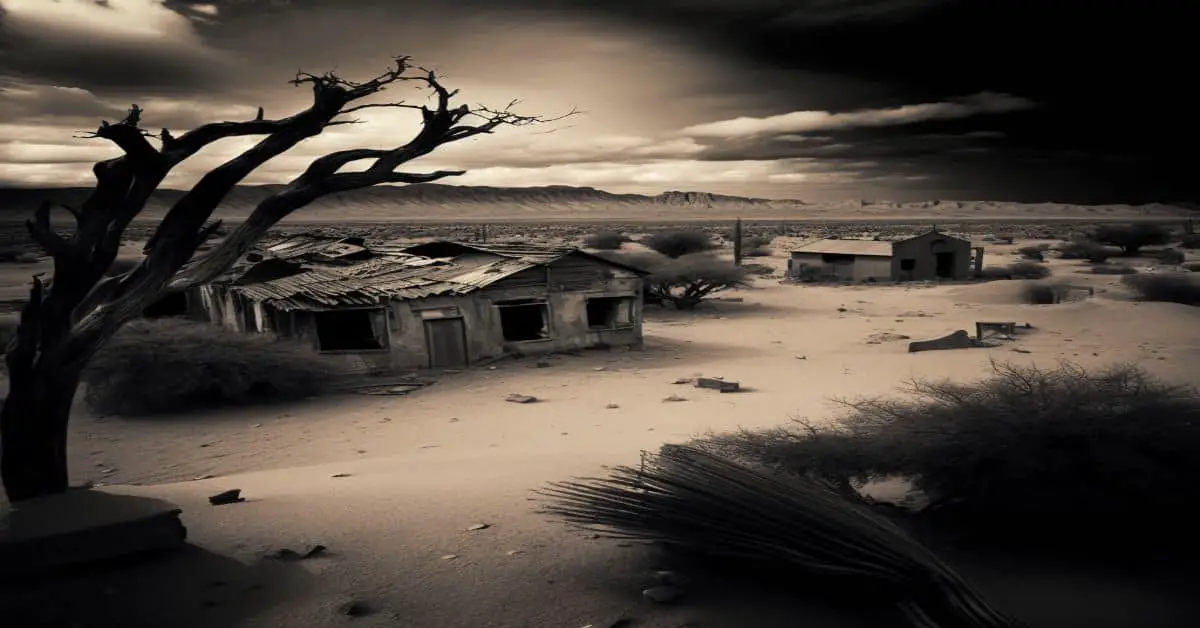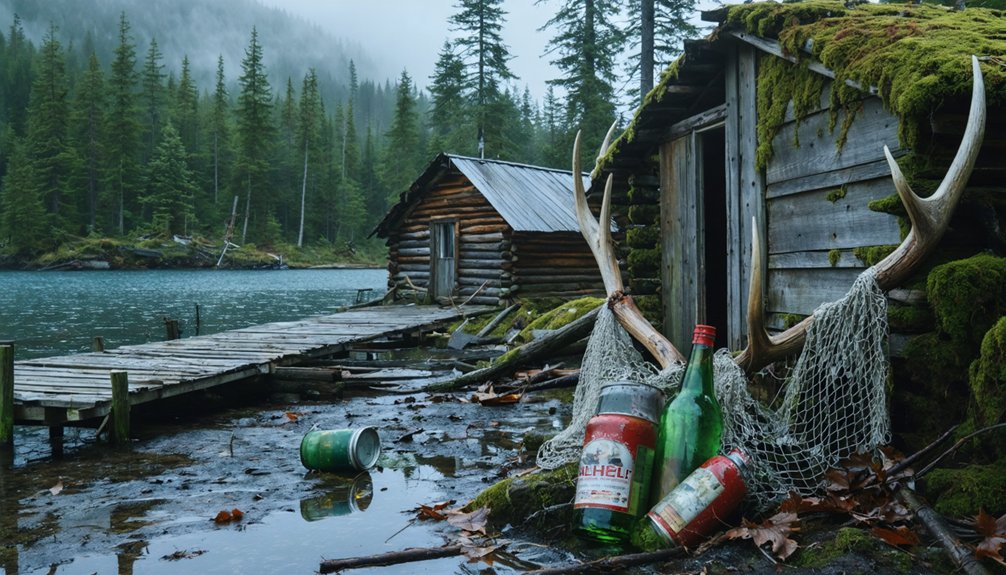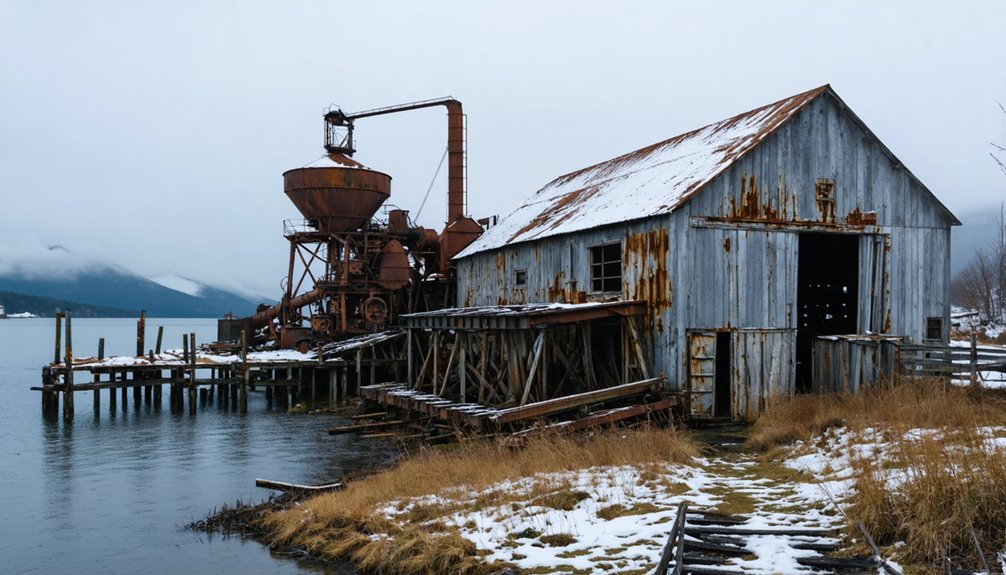You’ll find Kijik nestled along Alaska’s Lake Clark, where a thriving Dena’ina Athabascan settlement once housed up to 175 residents in the late 1800s. Archaeological excavations have revealed 12 log cabins, a Russian Orthodox church, and communal structures that showcase the blending of native and colonial influences. After devastating epidemics struck in 1900-1901, the population plummeted from 91 to 25, leading to abandonment. Today’s 1,920-acre National Historic Landmark holds countless untold stories beneath its surface.
Key Takeaways
- Kijik was once a thriving Dena’ina Athabascan settlement along Lake Clark, reaching its peak population of 175 residents between 1875-1890.
- The village contained twelve log houses, a Russian Orthodox church, and communal buildings before its abandonment.
- Disease outbreaks devastated the population, reducing it from 91 to 25 residents between 1900-1901, leading to the village’s abandonment.
- By 1910, only the church, two houses, and cemetery remained as residents relocated to other settlements like Nondalton.
- The site is now preserved as Kijik Archaeological District, spanning 1,920 acres within Lake Clark National Park and Preserve.
The Origins of Qizhjeh: A Dena’ina Settlement
Located strategically at Lake Clark, Qizhjeh (now known as Kijik) emerged as an essential Dena’ina settlement that played a central role in Alaska’s indigenous trade networks. Archaeological discoveries have uncovered the foundations of twelve log houses and two communal structures, revealing the settlement’s sophisticated organization and scope. The village reached its peak with 91 recorded residents during the 1880 U.S. Census.
You’ll find that Qizhjeh’s placement wasn’t random – it reflected the Dena’ina people’s masterful environmental adaptation. The location allowed them to connect with settlements at Stony River and Telaquana Lake while maintaining efficient hunting grounds and resource-gathering areas. After the devastating smallpox epidemic of 1836-1840, many Dena’ina residents embraced Orthodox Christianity while preserving their traditional cultural practices.
The Dena’ina’s deep understanding of their surroundings shaped their cultural practices and survival strategies, leading to a thriving community that sustained itself through organized hunting, resource sharing, and active participation in regional trade networks.
Life Along Lake Clark’s Shores
Along the shores of Lake Clark, human habitation stretches back an astounding 10,000 years, with the earliest evidence emerging from Bristol Bay.
You’ll find traces of distinct cultures that thrived here: the Paleo-Arctic peoples, Northern Archaic groups, and the Arctic Small Tool tradition – each leaving their mark on this rugged landscape.
When you examine Kijik history through subsistence strategies, you’ll discover how the Dena’ina mastered life in this challenging environment.
They’d move seasonally to follow resources, primarily focusing on salmon fishing while supplementing their diet through hunting and gathering.
During the Little Ice Age, they adapted their practices to survive harsh climate shifts.
The introduction of fur trading by Russians and Americans transformed their traditional economy, demonstrating their remarkable ability to adjust to changing circumstances.
The area became part of Lake Clark National Park in 1980, preserving these important cultural sites for future generations.
Russian Orthodox Influence and Cultural Change
At Kijik’s hilltop site, you’ll find the remnants of an Orthodox church built in the late 1870s, featuring the distinctive onion dome design and icon-rich interior that characterized Russian religious architecture in Alaska.
Through church records and archaeological evidence, you can trace how Orthodox practices merged with Dena’ina spiritual traditions, creating a unique religious syncretism evident in both burial customs and ceremonial artifacts. Following the example of Saint Innocent’s methods, missionaries adapted their teachings to respect and incorporate local cultural elements while sharing Orthodox Christianity. This approach reflected the earlier success of Russian missionaries who had baptized thousands of Alaska Natives within just three years of establishing their presence.
The church’s elevated position and central role in village life reflect its status as both a spiritual center and a cultural bridge between Russian Orthodox missionaries and the indigenous community.
Church Construction and Design
During the late 19th century, Kijik’s Russian Orthodox church emerged as a tribute to the growing religious transformation of Alaska’s Tanaina people, with construction likely occurring in 1877 or 1881.
The church architecture reflected traditional Russian Orthodox design principles adapted to Alaska’s harsh environment, featuring wooden construction, a rectangular plan, and a pitched roof topped with the symbolic onion dome representing the heavens. The missionaries’ approach of honoring local traditions helped ensure the community’s acceptance of the new church. Similar to other Orthodox churches in Alaska, it served as a gathering center for important community celebrations and times of mourning.
You’ll find this building embodied both cultural symbolism and practical considerations, as missionaries worked alongside native craftsmen to blend Russian ecclesiastical elements with indigenous building techniques.
The structure’s design incorporated local materials and elevated foundations to combat snow and moisture, while the interior maintained Orthodox traditions with an iconostasis.
This fusion of Russian and native influences created a unique space that served both religious and community functions.
Religious Life at Kijik
The Russian Orthodox Church profoundly shaped Kijik’s religious and cultural landscape through systematic missionary efforts that began in the late 18th century.
You’ll find evidence of this influence in three key aspects of Kijik’s religious life:
- Community gatherings centered around Orthodox feast days and celebrations, which blended native Dena’ina traditions with Christian practices.
- Spiritual rituals that showcase a unique syncretism, where traditional Native beliefs merged with Orthodox ceremonies, particularly visible in funeral customs and grave markings.
- The annual return of community members to maintain cultural connections through Orthodox-influenced harvest festivals and family reunions.
Regular visits by missionaries in the 1830s established a strong Orthodox presence through baptisms and religious services.
Despite facing challenges from harsh weather and competing religious groups, Orthodox practices became deeply woven into Kijik’s social fabric, creating a distinctive cultural identity that persists in modern observances. As documented in other Alaskan villages, the Russian Orthodox Church served as the primary institution shaping community understanding and responses to major events.
Native-Orthodox Faith Integration
Russian Orthodox missionaries who arrived in Alaska in 1794 brought profound changes to Kijik’s spiritual landscape, setting in motion a complex integration of faiths that would shape generations to come.
You’ll find evidence of this cultural adaptation in the unique faith expressions that emerged, as Dena’ina Athabascans wove Orthodox practices into their traditional beliefs.
While Orthodox icons and rituals became central to village life, Native spiritual traditions didn’t simply disappear. Instead, they evolved alongside new Christian practices.
The Dena’ina people maintained their connection to ancestral wisdom while embracing elements of Orthodox Christianity. This resilient approach to spirituality created a distinctive religious identity at Kijik, where traditional shamanic knowledge often complemented Orthodox teachings, demonstrating the community’s ability to preserve their cultural heritage while maneuvering around colonial influences.
The Village at Its Peak
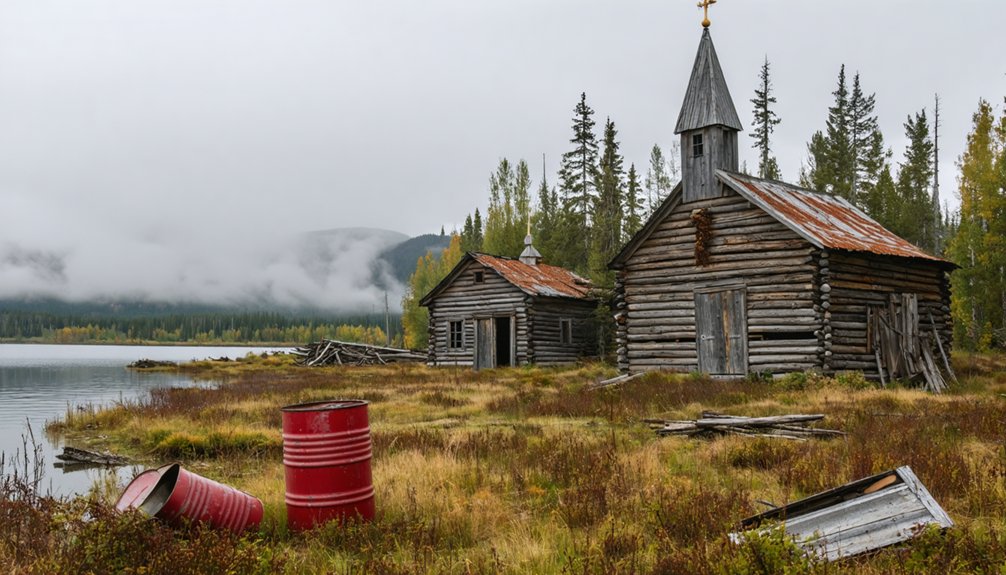
Vibrant activity marked Kijik’s peak period between 1875-1890, when this Dena’ina Athabascan settlement housed up to 175 residents.
Population dynamics fluctuated with seasonal variations as families moved between hunting grounds and trading posts, yet the village maintained its position as one of Alaska’s largest Athabascan communities. The 1880 Census documented 91 Kichik residents during this flourishing period.
You’ll find evidence of a thriving settlement through:
- 19 key structures including 12 log cabins, a Russian Orthodox church, and communal buildings
- Extensive trade networks connecting with the Alaska Commercial Company and neighboring Yupi’k and Alutiiq peoples
- Cultural gatherings centered around Qizhjeh Vena, where subsistence strategies focused on caribou hunting rather than salmon fishing
The community’s economic exchanges and social networks created a self-sufficient hub while incorporating new influences from western traders and Orthodox missionaries.
Disease, Decline, and Departure
While Kijik had flourished as a major Dena’ina settlement in the late 1800s, devastating disease outbreaks triggered its rapid decline after 1880. The disease impact was severe – combined measles and influenza epidemics between 1900-1901 reduced the population from 91 to just 25 residents by 1904.
You’ll find evidence of this decline in the village’s dismantled infrastructure, as survivors transported building materials to nearby settlements like Nondalton.
Community migration became inevitable as the epidemics continued. By 1910, only the church, two houses, and the cemetery remained at Kijik. This pattern of consolidation wasn’t unique – at least eight Dena’ina villages across the northern Kenai Peninsula experienced similar fates.
Though permanently abandoned, former residents continued returning to Kijik seasonally for traditional subsistence activities.
Archaeological Discoveries and Heritage
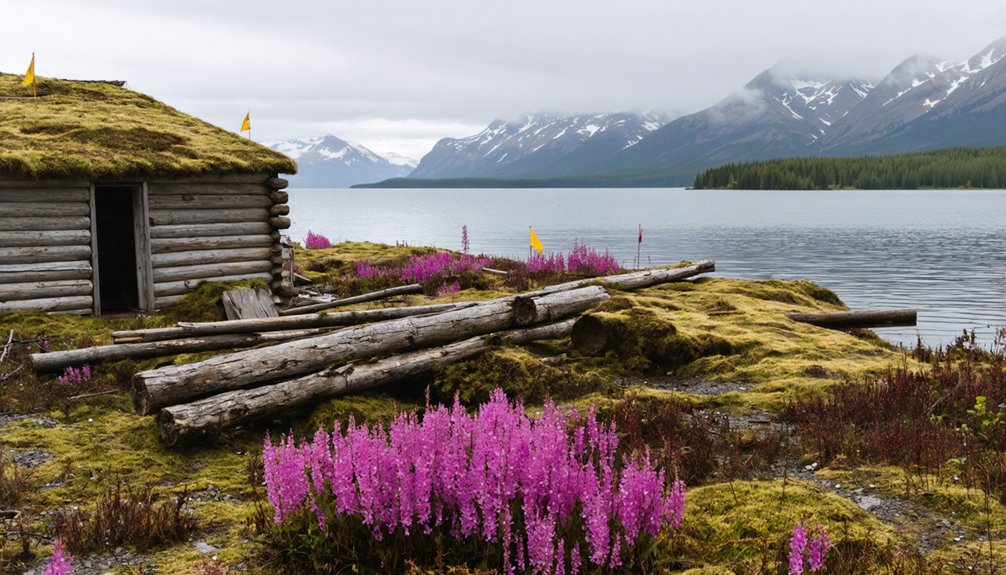
Through archaeological excavations at Kijik, you’ll find evidence of a sophisticated village layout featuring 19 structures, including log cabins, bathhouses, and an Orthodox church with skilled craftsmanship.
The site’s artifacts reveal a complex material culture centered on hunting and fishing tools, while multiple-room houses and storage caches demonstrate advanced food preservation methods.
You can trace the community’s cultural exchanges through one of Alaska’s largest collections of European trade goods, alongside traditional Dena’ina implements that showcase the village’s dual heritage.
Excavated Village Life Revealed
Major archaeological excavations in 1966 revealed the complex settlement patterns of Kijik, where researchers uncovered twelve log house foundations, five bathhouses, and numerous storage caches alongside a Russian Orthodox church and cemetery.
The Kijik architecture reflected both Russian and American influences, showcasing how the village adapted to changing times while maintaining traditional practices.
Key findings about village life include:
- Inhabitants relied primarily on caribou hunting rather than salmon fishing
- Storage caches demonstrated sophisticated resource management strategies
- Bathhouses played a central role in community health and hygiene
The artifacts tell a story of practical living, with utilitarian tools like whetstones, hammer stones, and bone awls dominating the subsistence strategies.
You’ll find few decorative items, suggesting a focus on survival and efficiency in this remote settlement.
Sacred Artifacts Preserve History
Sacred artifacts unearthed at Kijik offer profound insights into Alaska Native spiritual practices and daily rituals. These cultural artifacts serve as tangible links to your ancestral heritage, revealing how indigenous communities lived, worshipped, and sustained their traditions in this remote location.
You’ll find that professional excavations at Kijik have yielded remarkable discoveries that provide vital historical context. Each artifact tells a story of survival, ingenuity, and spiritual connection to the land.
The site’s significance extends beyond mere archaeological value – it’s a reflection of the enduring spirit of Alaska Native peoples. Through careful preservation efforts and community involvement, these sacred objects continue to educate future generations about their cultural roots.
The artifacts discovered at Kijik remain protected under law, ensuring their stories won’t be lost to time or erosion.
Sacred Ground: Modern Cultural Significance
While modern development encroaches on Alaska’s historic sites, Kijik stands as an enduring spiritual center for the Dena’ina people. This sacred ground reinforces cultural identity through:
- Annual ceremonies blending traditional and Russian Orthodox practices
- The Quk’ Taz’un culture camp where youth connect with ancestral connections
- Active subsistence practices that sustain traditional ways of life
You’ll find evidence of this living heritage across the 1,920-acre Archaeological District, where an estimated 200 graves line the shoreline.
Despite private ownership challenges, the Kijik Corporation works to reclaim these sacred lands. The site’s enduring significance manifests through continued use by elders and youth who return yearly to strengthen community bonds, harvest traditional resources, and honor their ancestors in this powerful landscape.
Traditional Practices and Knowledge
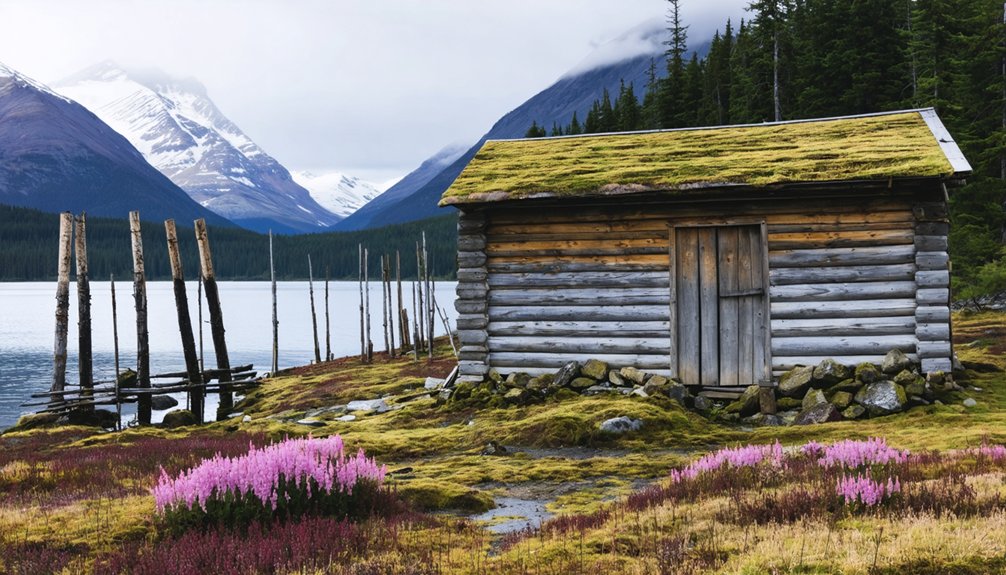
Deep within the Kijik Archaeological District, traditional Dena’ina practices reveal a surprising focus on inland caribou hunting rather than salmon fishing, despite the settlement’s proximity to water sources.
You’ll find evidence of these subsistence practices through carefully preserved artifacts, including whetstones, hammer stones, and skin scrapers that paint a picture of daily life.
The Dena’ina’s cultural tools tell a complex story of adaptation and resilience.
While Russian Orthodox influences brought significant changes to their spiritual practices, the community maintained its core traditions through communal living structures and shared knowledge.
Archaeological findings showcase how the settlement’s residents masterfully balanced their traditional ways with new cultural influences, as reflected in their hunting techniques and tool-making skills preserved in the district’s remains.
Preserving a Historical Legacy
Through decades of careful preservation efforts, the Kijik Archaeological District stands as a remarkable proof of Dena’ina cultural heritage, spanning 1,920 acres within Lake Clark National Park and Preserve.
You’ll find evidence of community engagement through programs like Quk’ Taz’un, which connects modern generations to their ancestral roots.
The site’s cultural preservation journey includes:
- National Historic Landmark designation in 1994, protecting archaeological treasures like underground caches and community houses
- Annual gatherings where residents honor ancestors and maintain traditional practices
- Ongoing protection of the Russian Orthodox church structure, though it now serves as a storage facility
Despite its ghost town status, Kijik remains alive through active stewardship and continued respect from local communities who maintain their connection to this sacred place.
Learning From the Past: Youth Education Today
Kijik’s rich archaeological record serves as a powerful educational tool for today’s youth, offering tangible connections to Alaska Native history and cultural heritage.
You’ll find the site’s twelve log houses and Russian Orthodox church remains provide hands-on learning opportunities about settlement patterns and colonial impacts.
The village’s story teaches significant lessons about epidemiology through its 1900 disease outbreak, while census records from 1880 to 1904 help you understand population dynamics.
Through field trips to Lake Clark National Park, you can explore archaeological methods firsthand and witness preservation efforts of this national historic landmark.
The educational impact extends beyond history, incorporating STEM principles, social sciences, and indigenous perspectives – demonstrating how one abandoned settlement continues to shape our understanding of Alaska’s complex past.
Frequently Asked Questions
What Dangerous Wildlife Did Kijik Residents Encounter in Their Daily Lives?
You’d face intense bear encounters daily, with Kodiak brown bears posing primary predator threats. Wolves, wolverines, and defensive moose added danger while hunting, fishing, or traveling through wilderness areas.
How Did Winters Affect Village Life and Survival in Kijik?
Like Netflix binges, you’d spend long winters indoors, facing brutal temps from -12°F to 30°F. You’d rely on stored foods, communal support, and traditional survival strategies to endure Kijik’s harsh season.
What Traditional Medicines and Healing Practices Were Used in Kijik?
You’ll find they relied on herbal remedies from local plants like berries and leaves, combined with shamanic practices involving healing touch, cleansing rituals, and animal-based medicines like seal oil for treatment.
How Did Villagers Preserve Food Without Modern Refrigeration Methods?
You’ll find they mastered traditional techniques like drying fish and meat, smoking their catch, fermenting berries, and storing food in underground pits or seal stomachs filled with preservative seal oil.
What Games and Recreational Activities Did Kijik Children Traditionally Play?
You’d find children playing traditional games like aigat string games to control daylight, angutinnguaq tag, and hunting simulations. They’d also make toy boats, throw spears, and slide on sealskins.
References
- https://en.wikipedia.org/wiki/Kijik
- https://www.alaska-stories.com/p/the-knik-alaska-story
- http://sites.rootsweb.com/~coleen/knik.html
- https://npshistory.com/publications/lacl/nr-kijik-hd.pdf
- https://www.nps.gov/lacl/learn/historyculture/kijik.htm
- https://auntphilstrunk.com/town-called-knik/
- https://www.youtube.com/watch?v=Cz0IGc2Uy0E
- https://alaskapublic.org/news/2016-07-08/ak-the-denaina-culture-camp-of-kijik
- https://npshistory.com/publications/lacl/op-32.pdf
- https://en.wikipedia.org/wiki/Knik_Site
